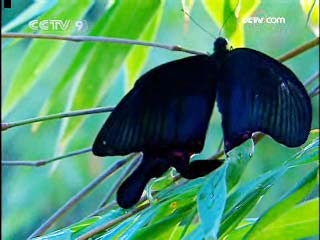------Program code: NS-080821-03015 (what's this?)
Source: CCTV.com
08-21-2008 10:22
 |
It can’t fly yet. But the hunters are advancing through the dark.
Dangers abound on the ground. So it must return to the tip of the bamboo as soon as possible.
 |
The cramer butterfly hides at the tip of the bamboo.
The cramer butterfly has two compound eyes, which observe where the sun shines on the bamboo stem. It senses the morning sunshine very early. It then finds a suitable position to receive as much sunshine as possible.
Within a couple of hours, the cramer butterfly needs to dry its wings and receive energy from the sun.
The dawn light revives the bamboo after the night.
Although the bamboo grow independently above the ground, they are connected to one another underground. Through this root system they can exchange nutrients and information. Botanists believe that a bamboo forest is, in fact, formed of just a single bamboo.
As the water on the cramer butterfly’s wings evaporates, it becomes lighter and more flexible. It’s about to fly for the first time in its life.
The cramer butterfly gets its first bird’s-eye view of the land. This region of China is rich in wild animals and plants. The moderate climate and moist red soil combine to form a habitat for more than 2,400 species of plants.
The diversity of plants is complemented by a similar diversity of animals. A huge variety of insects also live here, of which 4,600 species have been identified by scientists.
Like bees, butterflies also feed on nectar. But they get their energy to fly from the sun. The scales on their wings store solar energy.
With the sunset, the cramer butterfly loses the energy it needs to fly. It perches on a bamboo stem to escape the hunters. During the night, when the air is moist, the bamboo shoots grow rapidly, at twice the rate they did during the daytime.
The sun shines through the dense bamboo onto the bushes. The fragrance of alianthus prickly ash attracts the female butterflies to lay their eggs. The leaves will be food for the larvae. The male butterfly has to fly around searching for a mate. It must complete reproduction in the 30 days before the rainy season.
The male butterfly’s antennae intercept a faint smell in the air. It spreads its wings and heads for the distant valley.
The fresh April breeze, carrying moist air from the western Pacific, rustles through the bamboo, and covers the whole valley in a dense mist.
The male butterfly is lost without the sun to guide it. Even the smell in the air becomes elusive.
In the mist, the bamboo shoots grow even faster. They must grow quickly, if they are to have the best chance of avoiding the dangers that will come when the mist rises.
Editor:Yang
